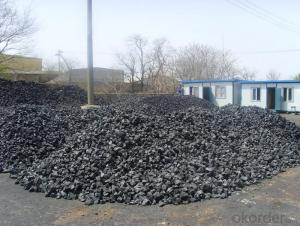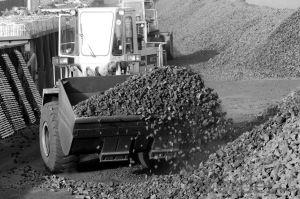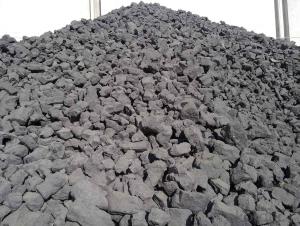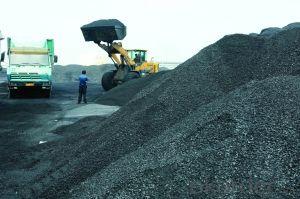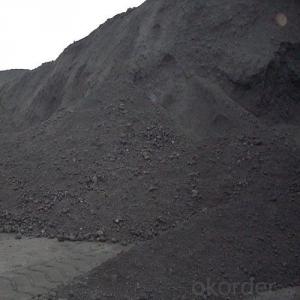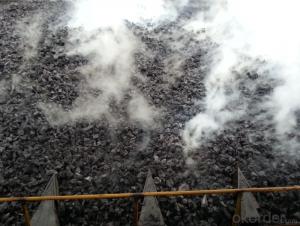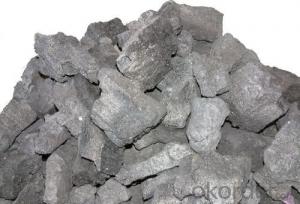Metallurgical Coke of Coke Strength after Reactivity 64
- Loading Port:
- Tianjin
- Payment Terms:
- TT OR LC
- Min Order Qty:
- 100 m.t.
- Supply Capability:
- 3000 m.t./month
OKorder Service Pledge
OKorder Financial Service
You Might Also Like
1. Structure of Metallurgical Coke of Coke Strength after Reactivity 64 Description:
Coke is made by high temperature metallurgical coke for blast furnace smelting, casting and gasification. Occurring in the process of coking after recovery and purification of coke oven gas is a high calorific value of fuel, is an important industrial raw material in organic synthesis.
Coke is mainly used for blast furnace ironmaking and used for copper, lead, zinc, titanium, antimony, mercury and other non-ferrous metal smelting of blast furnace, reducing agent, compound and the function of stock column frame.
Blast furnace with Coke instead of charcoal, which laid a foundation for the large-scale of modern blast furnace, is a major milestone in the history of metallurgy.
2. Main Features of the Metallurgical Coke of Coke Strength after Reactivity 64:
• Quality assurance
• Mutual benefit
• Preferential price
• Various choice
3. Metallurgical Coke of Coke Strength after Reactivity 64 Images:




4. Metallurgical Coke of Coke Strength after Reactivity 64 Specification:
Parameters | Guarantee | Rejection |
Total Moisture (As received basis) | 5% max | |
Ash (dry basis) | 12.5% max | > 13.5% |
Volatile Matter (dry basis) | 1.5% max | > 1.8% |
Sulphur (dry basis) | 0.65% max | > 0.75% |
Phosphorus (dry basis) | 0.035% max | > 0.045% |
M10 | 7% max | > 9% |
M40 | 84% min | <82% |
CSR | 64% min | <62% |
CRI | 26% max | > 28% |
Size 30-90 mm | 90% min | |
+90 mm | 5% max | > 8% |
-30mm | 5% max | > 8% |
5. FAQ
We have organized several common questions for our clients,may help you sincerely:
1) How to guarantee the quality of the products?
We have established the international advanced quality management system,every link from raw material to final product we have strict quality test;We resolutely put an end to unqualified products flowing into the market. At the same time, we will provide necessary follow-up service assurance.
2) What are coke's main physical properties?
The average heat capacity is 0.808 kj/(KGK) (100 ℃), 1.465 kj/(KGK) (1000 ℃)
Thermal conductivity is 2.64 kj/(MHK) (room temperature), 6.91 kj/(MHK) (900 ℃);
Ignition temperature (air) is 450-650 ℃.
3) How about your company?
Our company began to export coke when China cancelled 40% of coke export tariffs and quotas on January 1, 2013. We export many kinds of coke, such as CSR60 % and CSR 62% metallurgical coke (met coke), the NUT coke of 20 to 50 mm, coke breeze of 3 to 6 mm, and so on.
- Q: What is the use of petroleum coke
- According to the quality can be divided into two kinds of primary and qualified products. Qualified products are divided into six grades. Used in the manufacture of electrodes, calcium carbide, corundum and so on and used as a filling tank, also used as insulating materials and fuel, etc..
- Q: What are the indicators of first grade coke and the two grade coke?
- Two level 12.01-13.50 0.61-0.80 not less than 76 not greater than 9 not greater than 1.9Three level 13.51-15.00 0.81-1.00 not less than 72 not greater than 10 not greater than 1.9
- Q: What chemical plant used to coke
- . Coke obtained from high temperature coking for blast furnace smelting, casting and gasification. Coke oven gas produced in the process of coking and recovery is not only a high calorific value of fuel, but also an important industrial raw material for organic synthesis. Coke is mainly used in blast furnace ironmaking and smelting of non-ferrous metals such as copper, lead, zinc, titanium, antimony, mercury and so on. The use of coke instead of charcoal in the blast furnace has laid the foundation for the large-scale development of modern blast furnaces and is a major milestone in the history of metallurgy
- Q: What is the sample quantity of coke moisture test? What is the test time? How many degrees? That is the national standard.
- Test procedureDetermination of total moistureA, said the samples size less than 13mm with pre dried and weighed for about 500g (referred to 1g), smooth specimen,B, a sample tray is placed on the 170 a 180 C in the drying box, LH removed after cooling, weighing 5min. C, check dryness, each time 10min, until the two consecutive quality difference in LG, calculate the quality of the last time.Determination of moisture content of samplesA, with the weighing bottle drying to constant quality in advance and has quickly called weighing samples size less than 0.2mm uniform mixing of the 1 + 0.05g (referred to 0.0002g), flat on the weighing bottle.B, will be filled with a sample of the bottle to be placed in the 105-110 drying box drying 1H, remove the weighing bottle immediately covered with lid, put into the dryer to cool to room temperature (about 20min), weighing.C, check of dry, insult 15min, until two consecutive poor quality in 0.001g, take the quality of the last calculation, if quality is weight gain first calculated on the basis of.Five, the calculation of test resultsCalculation of total moisture content according to formula (L):
- Q: After the long-term use of non stick pan, oil stains can not be effectively removed, over a long period of time in the non stick coating on the formation of a layer of coke, the effect of losing non stick. As a result of this layer of coke is relatively dense and smooth, scouring cloth has been ineffective, steel ball can not be used to damage the coating, what chemical or physical methods to remove this layer of coke?
- Soak in hot water for a few hours (or a day and night).Two, with cooking shovel (Mason's Pihui knife is best) to remove surface soft.Three, the same with a spade close to the bottom of the pot to eradicate. Until the last thing left is black.
- Q: China's coke iron smelting began in what time?
- Han also invented the "fried steel law", that is, the use of pig iron "fried" mature iron or steel of the new process, the product is called steel. At the same time, the rise of "100 steelmaking" technology. The Eastern Han Dynasty (AD 25 ~ 220), when the emperor of the Ming Dynasty, invented the hydraulic blast furnace, that is, "water discharge". The invention of ancient water row in China, about 1100 years earlier than europe. After the Han Dynasty, the method of steel. "Qi Shu Qi, even referred to as" places "big steel", later known as the filling steel, also known as steel group. This is another important achievement of the ancient steelmaking technology in china. According to the "Encyclopedia of" records: Chinese is the earliest use of coal iron country, the Han Dynasty have been tried, song and Yuan dynasties have been popularized. To the Ming Dynasty (AD 1368 ~ 1644) has been able to use coke smelting pig iron.
- Q: With the number of 1 tons of steel smelting coke
- The use of coke pig iron smelting blast furnace, for each different, which is each blast furnace coke ratio (the ratio of the iron smelting a ton of coke by iron determined how many meals). The country or the world, the iron and steel enterprises coke are not the same, the coke rate is as low as possible, but there are many factors which restrict the level of coke, such as advanced level equipment, raw material and fuel quality, or the operator level, advanced process and so on many factors which influence
- Q: What is the difference between coke and carbon residue? Coke is a high-temperature refining, carbon residue can be used for civilian fuel it?
- Coke concept:Bituminous coal in the absence of air is heated to 950-1050 DEG C, after drying, pyrolysis, melting, bonding, curing and contraction of the final stage of this process is made of coke, coking high temperature (high temperature carbonization). By high temperature coking coke for blast furnace smelting, casting and gas generated in the process of coking. After the recovery and after the purification of coke oven gas is not only a high calorific value of fuel, and is an important raw material for organic synthesis industry. Metallurgical coke is coke, coke, iron alloy coke and non-ferrous metal smelting coke for metallurgical coke collectively. More than 90% were used for blast furnace ironmaking blast furnace coke, so often referred to as metallurgical coke is coke. The special cupola molten iron and coke. Coke is the main fuel cupola molten iron. It is melting charge and molten steel overheating, the support column to maintain its good permeability. Therefore, coke should Have large blocks, low reactivity, porosity is small, with impact crushing strength, low ash and sulfur enough.
- Q: Do not understand why some of the indicators of coke is the cause of the full analysis of phosphorus or foundry use of this time?It is best to use the foundry requirements? Thank you
- Phosphorus is a kind of harmful element in metal, which reduces the mechanical properties of castings. Under normal circumstances, GB castings of phosphorus content requirements of less than 0.06%, the lower the special requirements
- Q: Natural gas can replace coke smelting pig iron
- No, because the coke in the blast furnace to heat, reducing agent, skeleton and carbon supply four functions
Send your message to us
Metallurgical Coke of Coke Strength after Reactivity 64
- Loading Port:
- Tianjin
- Payment Terms:
- TT OR LC
- Min Order Qty:
- 100 m.t.
- Supply Capability:
- 3000 m.t./month
OKorder Service Pledge
OKorder Financial Service
Similar products
Hot products
Hot Searches



